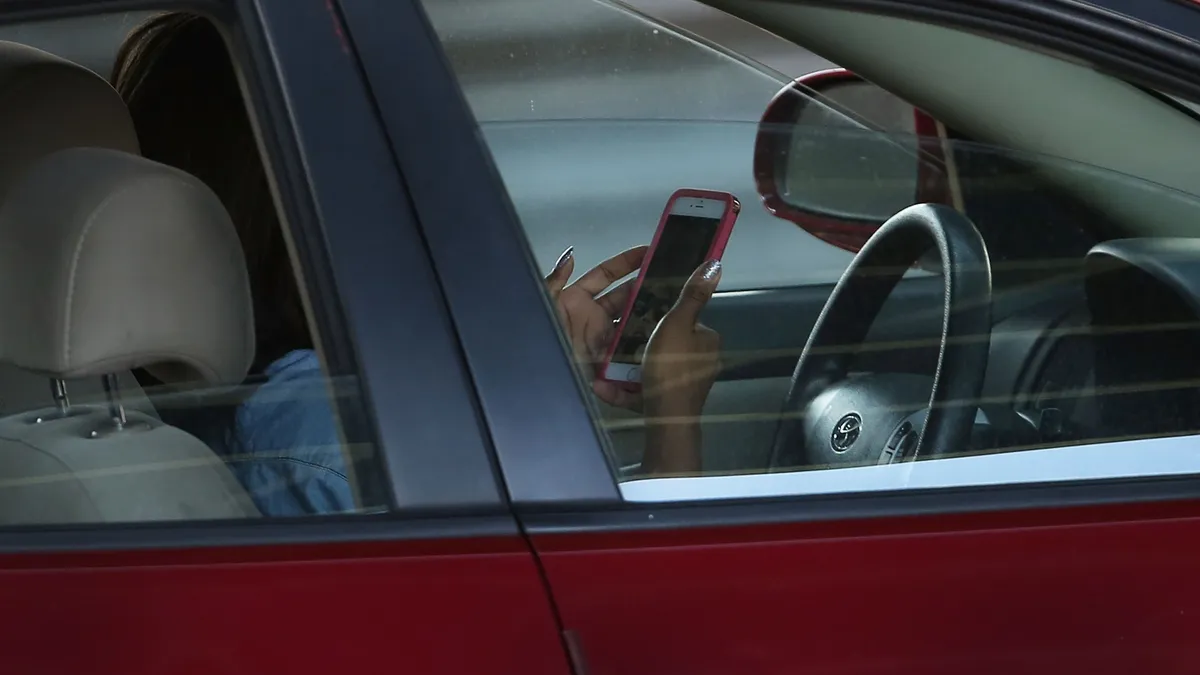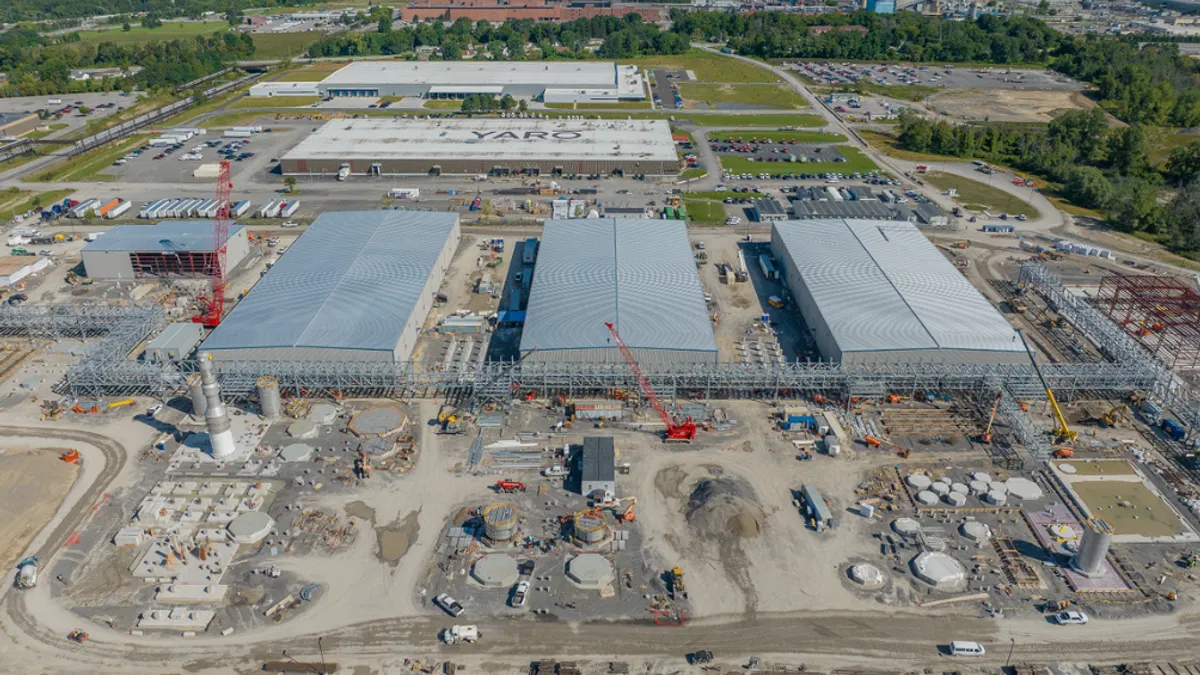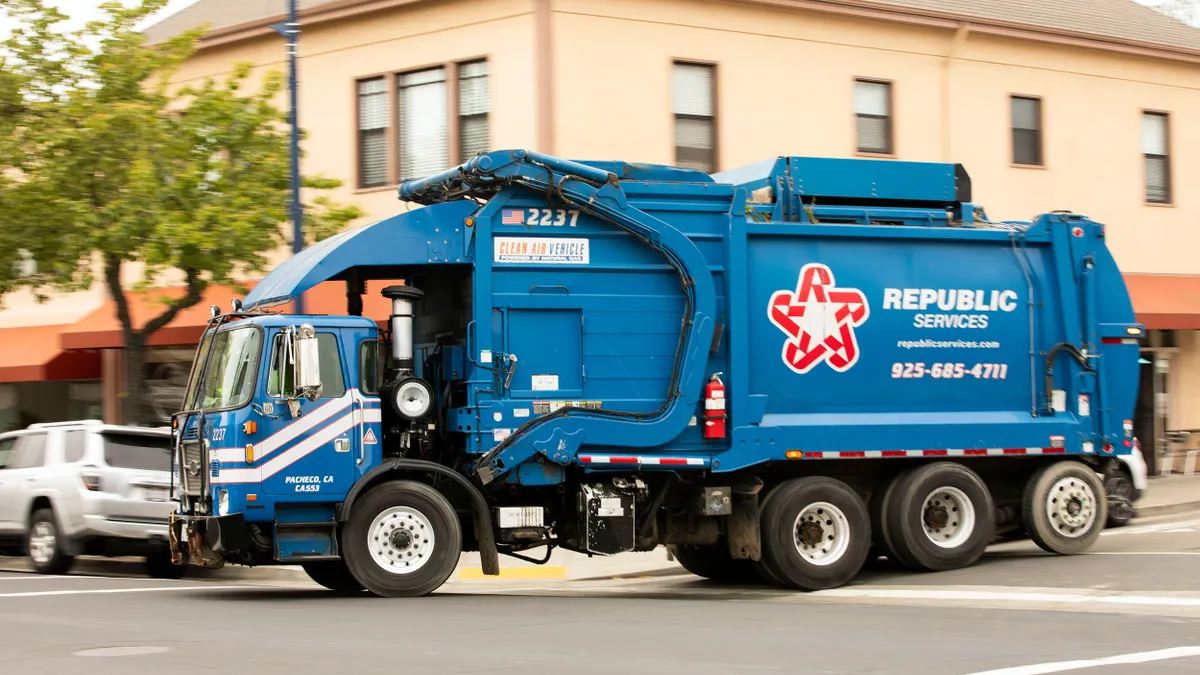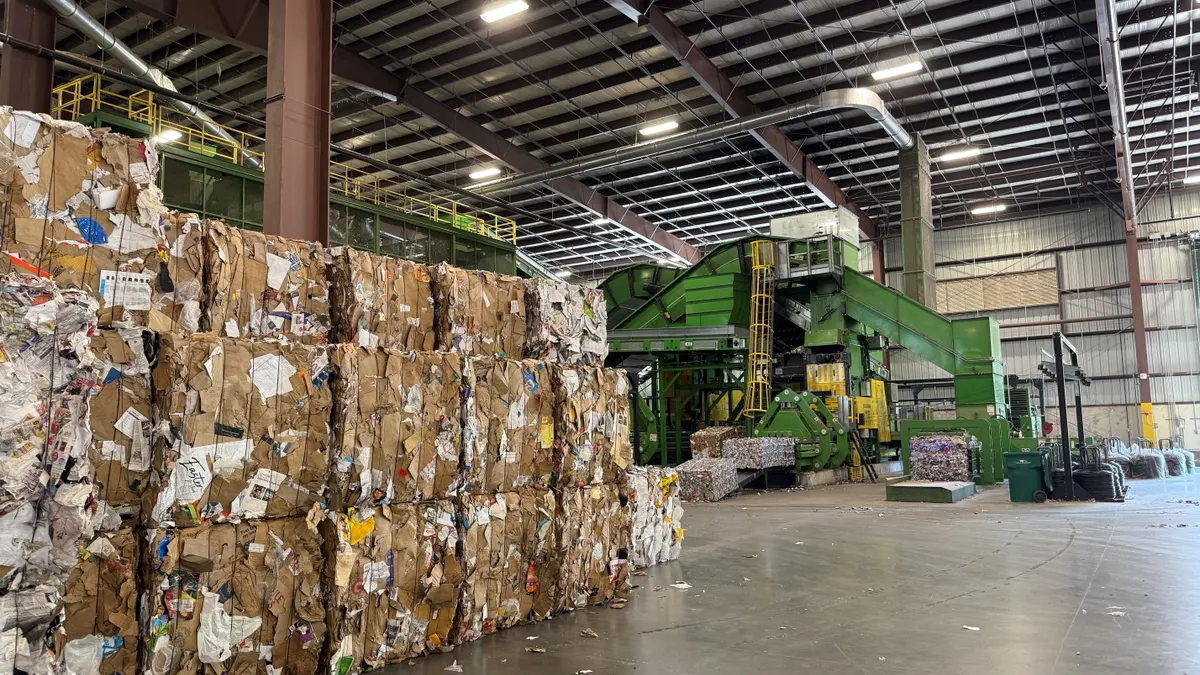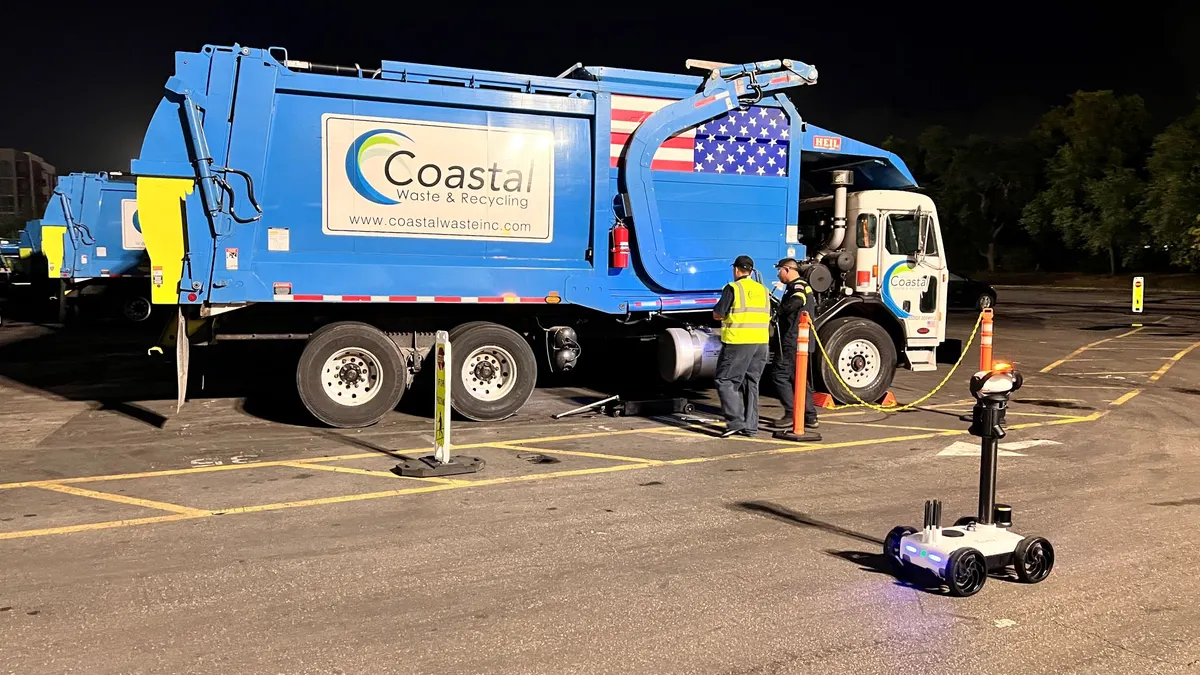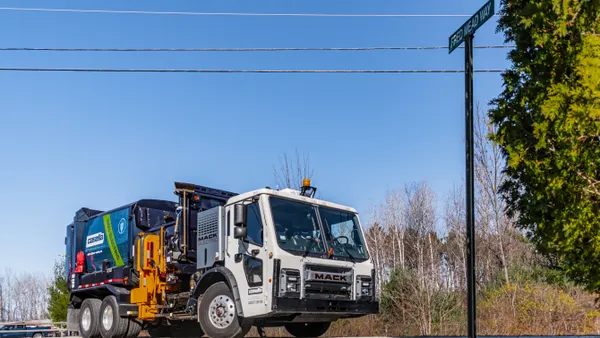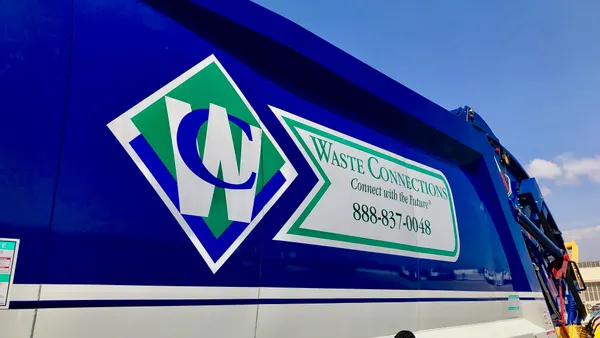Harold Bowman was a well-known face on trash day in Brown County, Ohio, before he died in his line of work. The owner of Bowman Waste Collections didn’t mind walking a few extra steps to grab a trash bin when a forgetful neighbor didn’t take it to the curb. Kids in the neighborhood liked to come outside to greet him when his truck rolled up, his customers said on the company Facebook page.
That same page filled with condolences after he was killed in June. Bowman was collecting trash at the end of a driveway along his usual route when he was struck by a driver who swerved to avoid rear-ending the collection truck. The Ohio State Highway Patrol told local station WLWT that Bowman's truck was displaying flashing lights, and he was wearing high-visibility safety equipment.
Other U.S. collection workers have been killed in similar crashes this year. In April in New York City, a van driver struck and killed a Cogent Waste Solutions collection worker while swerving around his garbage truck. And collection workers are not the only victims. In November, a passenger near San Diego died when a driver rammed a car into the back of a trash truck, then fled the scene.
Though these are some of the more recent examples, vehicle-related fatalities are not a new phenomenon for collection workers. Data from the U.S. Department of Labor's Bureau of Labor Statistics (BLS) lists “transportation accidents” as a significant cause of death for solid waste collection workers. While the factors leading to such accidents are not always recorded, distracted driving is believed to be a big contributor.
The waste industry points to the many steps it has taken to reduce the distracted driving hazards that collection workers face, but experts are split on current strategies' effectiveness and the potential of alternative or additional efforts. The industry has worked for years to get the word out about how to interact around waste vehicles, invested in in-cab safety technology, advocated for better cellphone regulations and called for more municipal, state and federal distracted driving initiatives. Some say better data collection and more engagement from federal regulators could also help.
What we know — and don't know
The limitations of existing data mean that much of what researchers and waste industry professionals know about distracted driving comes from anecdotal sources, but most believe that some combination of cellphones, impatient drivers and general lack of attention are contributing factors to many incidents each year.
The Solid Waste Association of North America counted 52 total waste worker fatalities in the U.S. and Canada in 2020, 36 of which were listed as “collection/driving” deaths. Of those, six were listed as “struck by vehicle.” Another nine were listed as “struck by waste vehicle.” SWANA also keeps track of members of the public who die in waste-related incidents, which in 2020 included 76 total people, 47 of whom were listed as either drivers or passengers. Another 22 were pedestrians, bicyclists or motorcyclists, according to the SWANA data.
BLS uses different metrics than SWANA to count collection worker deaths, but its findings also point to vehicle-related incidents as a major cause of death.
BLS released its 2020 fatality data Dec. 16, which counted 31 U.S. fatalities related to the “solid waste collection” category, with 16 of those related to “transportation accidents.” This year, overall collection worker fatalities decreased, but the occupation remains the sixth deadliest occupation in America. It was the second time since 2012 that refuse and recyclable material collectors were not in the top five deadliest occupations, according to BLS data, and the total was down significantly from 2018's spike to 57 fatalities, including 44 transportation incidents.
The waste and recycling industry, researchers and federal agencies all seem to agree that distracted driving is a huge part of the problem behind collection worker fatalities. Still, none of them believe they have a complete picture of the role distracted driving plays. Some experts say better data on its causes and impacts would offer clearer insight that could help lower the injury and fatality numbers that make waste collection among the deadliest jobs in the United States.
Jesse Maxwell, SWANA’s advocacy and safety senior manager who compiles data on industry fatalities, said he combs through reports from municipalities, police and local news for clues that could offer insight. Even in places where record-keeping is meticulous, “the underlying causes of a crash — were they looking at a phone or something when it happened? — we don’t always know that.”
One reason for that information gap: When accidents end in a fatality, “there may not be anyone left to describe what happened,” said Jane Terry, vice president of government affairs for the National Safety Council (NSC), which tracks distracted driving accidents and other factors that contribute to vehicle crashes.
Researchers and organizations like NSC believe distracted driving numbers are underreported. By one estimate from the Centers for Disease Control and Prevention, about eight people in the U.S. are killed every day in crashes reported to involve a distracted driver. The word “reported” does a lot of heavy lifting in these reports, Terry said, because this type of data relies on anecdotal information from police reports or voluntary details from those involved in the collision.
Police reports on crashes aren’t standardized in how they ask for distracted driving information, the National Highway Traffic Safety Administration (NHTSA) notes in its 2018 distracted driving report, so those reports can leave out important information that could help prevent future crashes.
“Police crash reports vary across jurisdictions, thus creating potential inconsistencies in reporting. Many variables on the police crash report are nearly universal, but distraction is not one of those variables,” the NHTSA report states. According to the Governors Highway Safety Association, most police crash report forms have some kind of field to list potential distracted driving factors, but New Hampshire and Connecticut specifically do not.
Shame is another factor that may lead to lower reported distracted driving numbers, the NHTSA report notes. Drivers involved in these incidents are less likely to tell police they were distracted before a crash because “there are negative implications associated with distracted driving — especially in conjunction with a crash.” Survey research shows that “self-reporting of negative behavior is lower than actual occurrence of that negative behavior."
Researchers are working to change this fuzzy picture. The Environmental Research & Education Foundation is working with the National Waste & Recycling Association to compile clearer, more detailed data on waste and recycling industry crashes, injuries and fatalities, which could also give a clearer sense of how distractions play into the numbers, said Kirk Sander, NWRA's vice president of safety and standards.
Education efforts
Avoiding distracted driving incidents takes cooperation between collection workers and the public, NSC's Terry said. Waste collection workers — along with tow-truck drivers and professionals in other industries at high risk for experiencing a transportation-related injury or fatality — are on the road every day with members of the public who may not know how to drive safely around their vehicles.
“If you think about it, we have thousands of people turning driving age every day, so we certainly believe in driver education to understand road dangers better,” she said.
Broad education efforts on how passenger vehicles and waste vehicles should interact on the road are in the works, and the newly signed Infrastructure Investment and Jobs Act (IIJA) provides $200 million a year through fiscal year 2026 in safe streets grants to support programs meant to prevent transportation-related fatalities, including innovative “low-cost, high-impact strategies that can improve safety over a wider geographical area.”
Yet the continued focus on education and personal responsibility rings hollow for some waste and recycling professionals, who say they are frustrated with slow progress after years of watching preventable crashes take lives. “For years, the narrative has been to encourage drivers to ‘do the right thing.’ We’ve done that for years and years, and fatalities aren’t going down. We need something more,” said NWRA's Sander.
Hanging up on cellphone distractions
What else could move the needle on distracted driving? Sander suggests more restrictions on cellphones, for one. Drivers turn to cellphones for everything from navigation to music to messaging, which he argues makes them “the perfect distraction” when getting behind the wheel.
“From a public perspective, broadly, we have the understanding and belief that mobile phones are addictive,” he said.
In recent years, researchers from the Virginia Tech Transportation Institute have gained greater insight into driver behavior by installing cameras and other equipment in volunteers’ vehicles. They confirmed previously anecdotal reports that cellphones are among the biggest distractions, writing in a 2016 study that “electronic devices have high use rates and risk” and that distracted driving doubles a driver’s risk for an accident.
The Federal Motor Carrier Safety Administration already prohibits commercial vehicle drivers from texting and driving, and most states have similar laws that apply to the general public. Massachusetts issued almost 30,000 citations in 2020 with a minimum $100 fine, the first year it enacted its “hands-free” law forbidding drivers from handling phones in the car.
NWRA says more needs to be done to regulate the phones themselves, not just consumer behavior. Drivers can choose to use apps that silence text message alerts and phone calls during drive time, but Sander says companies such as Apple should make such technology the default — not an elective feature — when drivers get behind the wheel.
NWRA is working on a campaign to hold cellphone makers and regulatory bodies, such as the Consumer Product Safety Commission and NHTSA, accountable for the role phones can play in vehicle crashes.
In the past few months, NWRA has urged the White House Domestic Policy Council to coordinate federal efforts to address mobile phones and distracted driving and acknowledge how the dangers specifically affect waste and recycling collection workers. Sander said he’s frustrated with each federal agency’s claim that it doesn’t have jurisdiction over mobile phones.
In a separate Dec. 7 letter to the Senate Committee on Commerce, Science and Transportation, NWRA called for legislation mandating that new passenger vehicles have distracted driving prevention technology similar to the drunk/impaired driver prevention technology that was mandated as part of the IIJA.
“Legislation combating addictive products is what is needed to make a beneficial impact for our workers and America’s drivers,” said NWRA President and CEO Darrell Smith in the letter.
Representatives from the White House Domestic Policy Council and the Senate committee did not respond to requests for comment.
Revisiting state 'move over' laws
Beyond reducing common distractions such as cellphones and radios, NWRA, SWANA and others have focused on passing state laws that require drivers to use a certain amount of caution when approaching collection vehicles. However, it’s unclear how effective such laws have been to date, prompting more calls for discussion and research into these methods.
The laws, passed in 30 states and sometimes referred to as "slow down to get around" policies, define solid waste collection trucks as service vehicles and require drivers to yield to the vehicles, as well as to employees working on them, when their lights are flashing and collections are occurring. Slow down to get around laws expand on what are sometimes known as “move over” laws for emergency, law enforcement and some service vehicles.
“Getting a move over law that covers waste and recycling workers as well as emergency vehicles is really important,” Sander said, but often the bigger hurdle is raising awareness that such laws exist. Many drivers — or law enforcement officers — simply aren’t aware that waste vehicles are part of the law, leaving the burden of education to fall on waste companies that affix “slow down to get around” decals on their trucks. Maryland, for example, has included waste vehicles in its move over law since 2018, but its educational website does not specifically mention waste and recycling vehicles.
States also enforce slow down to get around laws unevenly, with some states imposing fines for violators while others treat the laws more as awareness campaigns. Kentucky passed its slow down law in 2017 but did not include any penalties when its legislature passed the bill.
Despite the hurdles, NWRA believes the slow down laws are a valuable tool to prevent more vehicle-related deaths among collection workers. The IIJA could help work out some of the inconsistencies in how such laws are applied. The legislation calls for a study to review the efficacy of such state programs and offer recommendations to improve public awareness campaigns, research or education efforts. This could help streamline existing programs and solidify messaging long-term, Maxwell said.
“At the end of the day, we know this is a dangerous job,” he said. “But sometimes the public truly doesn’t know how dangerous.”
Leaning in on driver-assistance technologies
Distracted driver campaigns tend to focus on how to change driver behavior, but waste companies have long been familiar with truck technology they believe helps reduce accident risks.
Among the options is “dashcam” hardware that records both driver and traffic behavior in an effort to both hold drivers accountable and collect data and evidence that can prove who was responsible for a crash. Most major waste companies say dashcams are increasingly common in their vehicles.
John Andel, corporate director of health, safety and compliance at Leck Waste Services in Pennsylvania, credits a suite of safety improvements for helping reduce accidents and near-misses involving the company's collection vehicles and reducing its insurance premiums. In addition to requiring drivers to take a defensive driving class, Leck invested in 3rd Eye camera systems, which monitor driver behavior with five to eight cameras inside each waste vehicle, he said during a SWANA safety summit meeting in March.
Andel said he initially faced pushback from drivers, who felt the cameras meant the company didn’t trust them to do their jobs, but the drivers eventually came to appreciate the way the cameras could record incidents that showed another driver was at fault.
The recordings may also capture teachable moments.
“When an accident happens between a Toyota Corolla and a trash truck, the impulse might be to blame the truck. But these cameras exonerate the drivers. They are also good training tools, especially when [they record] these drivers that have years and years and years of experience, and the cameras show ways they react well in stressful situations," NSC’s Terry added
Andel encourages smaller waste companies to invest in the equipment as well, but he acknowledges that pandemic-related budget cuts and other capital investment priorities may put the tech just out of reach.
Automated side-loading waste vehicles, designed so collection workers don’t need to leave the cab to empty curbside trash bins, are another technology municipalities and waste haulers hope can make a difference in reducing struck-by incidents or other hazards such as slips and trips, but they carry a high price tag.
What’s next for tackling driver distractions
Whether waste companies invest in more truck technology, training, or other options, most advocates agree that the industry and the general public still need to adopt broader, longer-term solutions to fight distracted driving. Overall traffic deaths have been on the rise since the beginning of the pandemic, adding to the sense of urgency, Terry said.
In the first half of 2021, traffic deaths were up by 18% compared with the same period in 2020, according to NHTSA’s preliminary estimate. Transportation Secretary Pete Buttigieg said in a release the numbers show the country is in “crisis” and announced the department would work on a national roadway safety strategy to better identify ways to bring the numbers down.
Some critics say distraction-related injuries and fatalities won’t decrease based on public education campaigns or defensive driving alone. Campaigns like the Vision Zero Network, which aims to eliminate all traffic-related injuries and fatalities, say too many crash prevention programs hinge on promoting perfect driving behavior instead of building a multilayered approach that includes broader policy change, traffic engineering improvements and lower speed limits.
Some researchers have called for better access to vehicle technology through grant programs or other means. Some want vehicle manufacturers to take more responsibility for road safety by making features such as backup cameras and forward collision warning systems standard features rather than add-on options. Others point to Europe’s use of pedestrian safety tests for vehicles as a contributing factor to that region's decline in pedestrian deaths.
The U.S. Department of Transportation last year released its Pedestrian Safety Action Plan, which calls for updating how new cars' safety features are assessed, but many of the other near-term solutions it poses relate to public awareness campaigns instead of policy changes.
Future updates to city infrastructure could also play a part in reducing crashes, Terry said. The concept of “vehicle-to-infrastructure” technology, wherein infrastructure such as stoplights could communicate with cars or waste vehicles to alert drivers to unexpected road obstructions or stopped traffic, is gaining interest but is yet to be yet implemented, she said.
“We want to work with partners on tech solutions — both brand-new and existing,” that can better alert drivers about incidents happening around them, Terry said.
NWRA's Sander said cities and states can also think about changing local laws to calm traffic or reduce interactions between waste vehicles and passenger cars.
Noise ordinances in Washington, D.C., for example, dictate that private haulers cannot collect trash and recycling in certain residential areas before 7 a.m. As the city builds more and more housing, “traffic is getting more crazy, and more people are moving in. Wouldn’t it make sense to get the trucks off the street early?” he said.
Funding in the IIJA Act could also help, Terry said. The bill calls for a study on how effective technologies like cameras, audible warning systems and flashing light systems are on school buses, which could allow other industries that use similar technology to gain ideas and better insight into their own vehicles.
Although many factors can cause crashes between collection vehicles and the public, Terry said distracted driving is a major focus for prevention and education efforts because it’s based on habits and actions that can be changed. Even the best-trained or most experienced drivers can be susceptible to distracted driving habits, including collection workers, “who are professionally trained drivers that are good at what they do,” Terry said.
“We need everyone to redouble their safety efforts, which not only helps [collection workers] but also helps their families and friends.”



